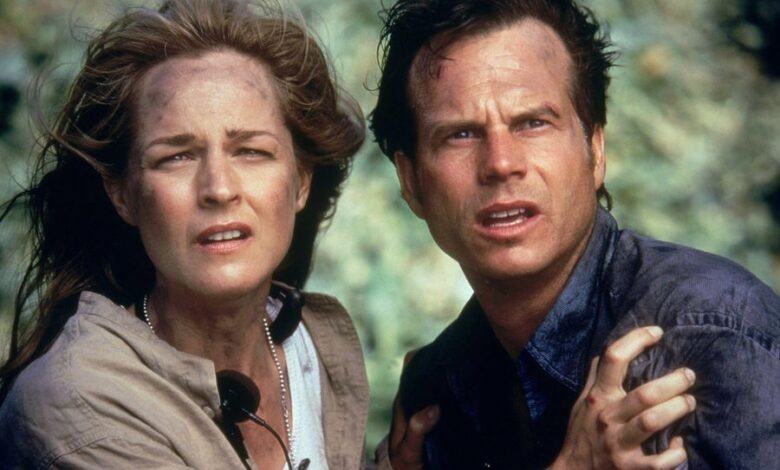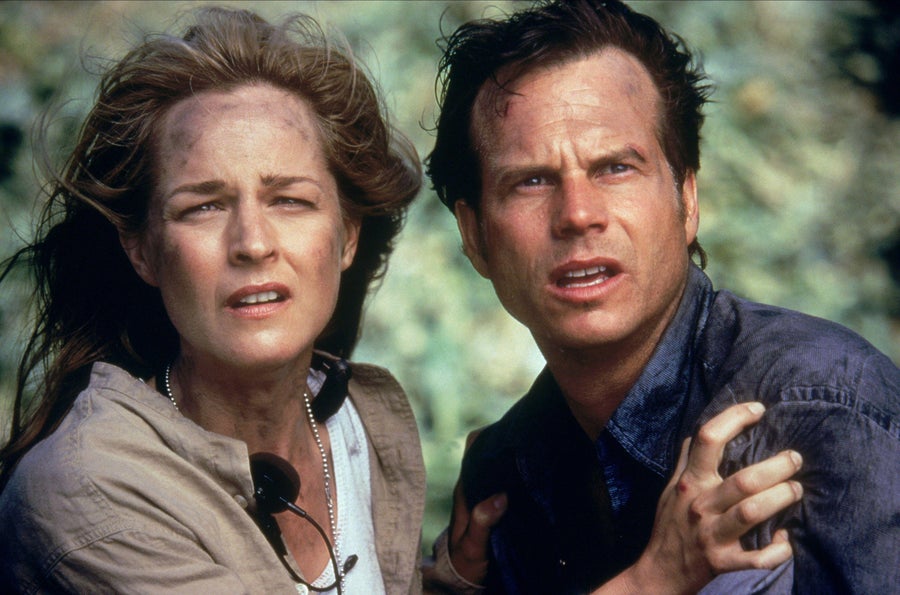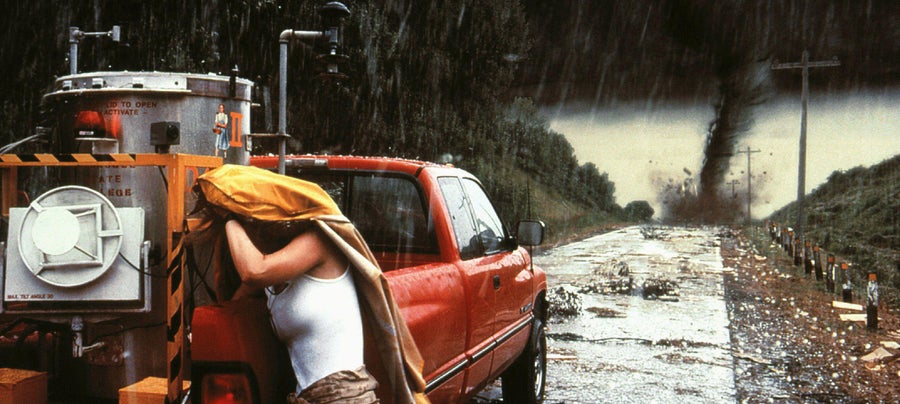
The meteorological community has a bit of a love-hate relationship with Twister, the 1996 blockbuster about tornado-chasing scientists. The movie plays a little fast and loose with some aspects of science—and is certainly more action-packed than the average tornado chase. But it is undeniably fun, dramatic and mesmerizing. And it remains beloved by many meteorologists and weather enthusiasts (including the author of this article).
With excitement high over the recent release of the film’s stand-alone sequel, Twisters, Scientific American reached out to tornado experts Rick Smith and Jana Houser to chat about why so many in the weather community love the original movie, what they think about the new sequel and what the ups and downs of studying tornadoes are. Smith is warning coordination meteorologist at the National Weather Service’s (NWS’s) office in Norman, Okla., who was consulted for Twisters and appears in the film as an extra. And Houser is a meteorologist at the Ohio State University who provided forecast and other support to the new movie’s cinematographers when storm chasing to film real storm backgrounds and clouds. [The following conversation includes some spoilers for the new film.]
[An edited transcript of the interview follows.]
On supporting science journalism
If you’re enjoying this article, consider supporting our award-winning journalism by subscribing. By purchasing a subscription you are helping to ensure the future of impactful stories about the discoveries and ideas shaping our world today.
I grew up with tornado drills in school, and I have vivid memories of my parents waking us up during the night to go down to our basement. When I was a teenager visiting my grandmother during the summer, we went to see Twister. I remember that right from the title sequence, I was just like, “I want to know everything about this. This is so cool.” (And I felt this when I just rewatched the movie recently.) I very much identified with Helen Hunt’s character Jo Harding. It lit my interest in weather and earth science in general.

Helen Hunt and Bill Paxton in Twister.
Universal Pictures/AJ Pics/Alamy Stock Photo
SMITH: Like a lot of people in this business, as far back as I can remember, I’ve been fascinated by weather and especially tornadoes. At the same time, I was also irrationally terrified of thunderstorms, especially at night. I also grew up in the Southeast, in the Memphis, Tenn., area. And that terror lasted probably into my early teens. But at the same time, I was just obsessed with tornadoes. I would go to the library and check out all the books over and over again and write to the NWS to get them to send me pamphlets and brochures and stuff. I was a real pest, I’m sure. But at some point it just got to be more of a positive thing, or it wasn’t as scary anymore. I actually got to be a volunteer at the NWS office there in Memphis. Then I got to be a student paid employee. Then I got to be a full-time employee.
I’ll never forget—I was working at the NWS in Memphis when Twister came out. And I remember I thought it was the biggest deal in the world. And I felt so special that they did a screening on [the] Wednesday night before it was released on Friday [May 10, 1996]. I thought, “Well, I’ve hit the big time.” I went with a bunch of people from the office, and it was about what you would expect: a lot of giggling and groaning and mumbling. They were just there to pick it apart—which I was not. I’ve been a fan ever since, and I freely admit I will stop and watch part of it every time I’m flipping through the channels … even today. And regardless of what the new movie is or how we think about it, Twister is always going to hold a special place for me.
HOUSER: We joke in this field that we’re, like, genetically modified from birth, basically, to have this propensity and this love for storms. I grew up in eastern Pennsylvania, so not really anywhere tornado-prone. I never had a tornado experience growing up. My interest was really piqued, probably, in second grade. I can remember playing with my cousin where my dad had a thermometer and a rain gauge. And she would pretend to be the camera person, and I would pretend to be the little on-camera meteorologist and just, like, look up at the sky and say, “Oh, the clouds are this; it’s going to be partly sunny.”
Moving forward, in April 1991 there was a really big tornado outbreak that really impacted me. I was in roughly third grade at the time and can remember being …, enthralled by it. And I was terrified of thunderstorms as a child…. And similarly to Rick, I would go to the library and just scoop up anything I could possibly find. And that passion just continued. I always wanted to pursue meteorology.
When Twister came out, I was a teenager and can really remember being like, “Yes, this is what I want to do with my life.”
Do you watch the old movie and the new one and think that it’s cool to see yourself sort of represented and celebrated as meteorologists? Both of them feel to me a little like love letters to the people who are so obsessed with tornadoes.
SMITH: You have to detach your science brain to enjoy the movies. But the new movie—there’s more connection there, I think, and more reality in many ways.
I forgot to mention that the Friday that Twister came out, we were leaving at six o’clock the next morning to go on my first chase vacation, so that really kind of set the stage and set the disappointment level super high for when we hit the road.
HOUSER: Well, I have to say, on my very first chasing experience, I saw eight tornadoes, and I’ve never, to date, seen eight tornadoes again. So my first experience set the bar so high, and it just hasn’t been met.
I didn’t really touch a whole lot on the impact of Twister in my personal life as a teenager, but that was a really motivational movie for me. And I still love it. As Rick was mentioning, I still like to just throw that on. And even though there are some little quirks and some little faux pas in there, it’s a very exciting and really kind of passion-driving experience. And then, with Twisters, seeing the chase culture being portrayed on the big screen in a relatively realistic way. Now, we’re not trying to beat each other to the tornadoes, and there’s not a sort of science-versus-YouTubers aspect, at least in the context that it was portrayed in the movie. But it is cool to see the lingo. And I totally credit Rick and the other science advisers for this movie with doing that: talking about storm interactions and cold pools and using terminology that we use in the field.
I find it hard—when you know something about earth science, and you go to a related movie, you’re bursting trying not to spoil it for other people. I was worried about the “we’re gonna try and tame a tornado” aspect of Twisters. But I can see where they went with the idea of trying to dissipate the tornado. I can suspend disbelief enough.

Helen Hunt’s character Jo Harding works to ready one of the “Dorothy” measurement apparatuses in Twister.
Universal Pictures/Cinematic/Alamy Stock Photo
HOUSER: Yeah, and I understand, definitely, why they did it for the storyline—and it works with the storyline. I think my biggest sort of rub, I guess, is that there are people who are really stupid enough to try this. Every year to multiple times a year, I have people contacting me like, “Hey, did anybody ever try to do blah, blah, blah,” or, “I have this really great idea for blah, blah, blah,” and you’re like, “No—you clearly have no idea.”
SMITH: You are getting all those phone calls we’re forwarding to you! Good.
I was wondering if some lawmakers might think that this is something we can actually do—whether they might try to push the NWS to dissipate a tornado. Similarly, are people who are interested in storm chasing but don’t have the background going to be like, “I’m gonna go shoot fireworks off in a tornado”?
SMITH: That’s going to happen.
HOUSER: That’s totally going to happen.
SMITH: It’ll happen before the year is over, I’m sure.
But, yeah, the science behind the disruption [of a tornado]—Kevin Kelleher, who used to be deputy director of the National Severe Storms Lab [at the National Oceanic and Atmospheric Administration], was the movie’s full-time tornado consultant. He was there from the early stages of the script, and he did everything he could, and they were very receptive. And actually, the science behind all of that is there. But the practicality of it isn’t there—you would need 20,000 tons of the material [they use to absorb moisture in the movie] and somehow be able to introduce it into just the right part of the storm quickly enough. And how do you pick the storm? And then what happens—when there’s the downburst that comes out of the storm when the storm collapses—is probably worse than the tornado would have been if you had just left it alone. There are just so many problems with it, but I accept it because it was a dramatic moment and a cool end to the movie. I certainly hope nobody thinks they can actually go do that.
I do like that you really go on much more of an emotional journey with the main character, Kate, in this movie.
SMITH: [The two films] both have a dramatic event that kind of kicks off the movie, that sets the main character off onto their journey. But the way Jo responded to that—she was obsessed and wanted to be in the tornado, wanted to see it. Whereas Kate, she just quit and went to work for the NWS for five years. I focus a lot on PTSD [post-traumatic stress disorder]. We’ve done presentations at conferences and things, and I was glad to see this being brought up in the movie. You can see [that in Daisy Edgar-Jones’s performance as Kate], like when she comes back to Oklahoma and [Anthony Ramos’s character] Javi is driving her in the truck. They drive under a bridge, and the way she’s looking at the overpass as they drive under it—I don’t know, you can just feel what she’s probably feeling. So the dramatic events—both movies have that, but what it does to the main character is different.

Daisy Edgar-Jones as Kate and Glen Powell as Tyler Owens in Twisters.
Amblin Entertainment/The Kennedy/Marshall Company/Universal Pictures/Warner Bros./Lightnin’ Production Rentals/Album/Alamy Stock Photo
Is there anything else either of you wanted to add?
HOUSER: I was just thrilled to be involved in the production in any capacity at all. And it was just a really great opportunity for me to get out and to experience chasing in a different way than what I oftentimes do experience. I’m a professor, so I’m going out most of the time with a research effort or taking students out for experiential learning purposes. So for this film, I was able to actually really focus on the visual aesthetics.
SMITH: I’m also honored to have been just a tiny part of it, too. We got to meet with the cast before they started shooting and do a little spotter training class for them and a tornado culture kind of thing. And I think they really responded well to that. And just getting to be on the set for a little “don’t blink; you’ll miss it” scene in the NWS office. Even before they started filming the movie, we were just kind of setting the stage for them as far as “Welcome to Oklahoma. You’re filming a movie about tornadoes, but you’re going to be living with people who live tornadoes for real, all the time, and who have been through traumatic events themselves.” I thought it was just awesome to be a part of it. And I hope they do a sequel and that doesn’t take 28 years to do.




